Just a day after they announced that Rosetta could be flying by the end of the month, the European Space Agency decided to put the mission on hold indefinitely because of their concerns with the Ariane-5 rocket. Unfortunately, since Rosetta won’t be launching by the end of the month, it won’t be able to meet up with Comet Wirtanen. by 2011, so the entire mission will need to be redesigned to seek a new target.
Three new moons discovered for Neptune
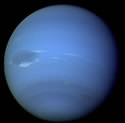
Image credit: NASA
A team of astronomers from the Harvard-Smithsonian Center for Astrophysics have discovered three previously unknown moons orbiting the planet Neptune. Since they’re only 30-40km across, the moons were a challenge to spot. The team had to digitally merge multiple exposures of the planet moving across a background of stars. Over time, the planets and their motions were picked up as points of light. This brings the gas giant’s total to 11 known moons.
A team of astronomers led by Matthew Holman (Harvard-Smithsonian Center for Astrophysics) and JJ Kavelaars (National Research Council of Canada) has discovered three previously unknown moons of Neptune. This boosts the number of known satellites of the gas giant to eleven. These moons are the first to be discovered orbiting Neptune since the Voyager II flyby in 1989, and the first discovered from a ground-based telescope since 1949.
It now appears that each giant planet’s irregular satellite population is the result of an ancient collision between a former moon and a passing comet or asteroid. “These collisional encounters result in the ejection of parts of the original parent moon and the production of families of satellites. Those families are exactly what we’re finding,” said Kavelaars.
The team that discovered these new satellites of Neptune includes Holman and Kavelaars, graduate student Tommy Grav (University of Oslo & Harvard-Smithsonian Center for Astrophysics), and undergraduate students Wesley Fraser and Dan Milisavljevic (McMaster University, Hamilton, Ontario, Canada).
Needle in a Haystack
The new satellites were a challenge to detect because they are only about 30-40 kilometers (18-24 miles) in size. Their small size and distance from the Sun prevent the satellites from shining any brighter than 25th magnitude, about 100 million times fainter than can be seen with the unaided eye.
To locate these new moons, Holman and Kavelaars utilized an innovative technique. Using the 4.0-meter Blanco telescope at the Cerro Tololo Inter-American Observatory, Chile, and the 3.6-meter Canada-France-Hawaii Telescope, Hawaii, they took multiple exposures of the sky surrounding the planet Neptune. After digitally tracking the motion of the planet as it moved across the sky, they then added many frames together to boost the signal of any faint objects. Since they tracked the planet’s motion, stars showed up in the final combined image as streaks of light, while the moons accompanying the planet appeared as points of light.
Prior to this find, two irregular satellites and six regular satellites of Neptune were known. The two irregular satellites are Triton, discovered in 1846 by William Lassell, and Nereid, discovered in 1949 by Gerard Kuiper. Triton is considered irregular because it orbits the planet in a direction opposite to the planet’s rotation, indicating that Triton is likely a captured Kuiper Belt Object. (The Kuiper Belt is a disk-shaped collection of icy objects that circle the Sun beyond the orbit of Neptune.) Nereid is considered irregular because it has a highly elliptical orbit around Neptune. In fact, its orbit is the most elliptical of any satellite in the solar system. Many scientists believe that Nereid once was a regular satellite whose orbit was disrupted when Triton was gravitationally captured. The six regular satellites were discovered by the Voyager probe during its encounter with Neptune. The three new satellites were missed by Voyager II because of their faintness and great distance from Neptune. According to Holman, “The discovery of these moons has opened a window through which we can observe the conditions in the solar system at the time the planets were forming.”
Tracking Faint Blips
The researchers are currently conducting follow-up observations to better define the orbits of the newfound moons using orbital predictions supplied by Brian Marsden (Director of the Minor Planet Center in Cambridge, Mass.) and Robert Jacobson (Jet Propulsion Laboratory).
To follow up the initial find, team members Brett Gladman (University of British Columbia, Canada); Jean-Marc Petit, Philippe Rousselot, and Olivier Mousis (Observatoire de Besancon, France); and Philip Nicholson and Valerio Carruba (Cornell University) conducted additional observations using the Hale 5-meter telescope on Mount Palomar and one of the four 8.2-meter telescopes of the European Southern Observatory’s Very Large Telescope at Paranal Observatory, Chile. Grav made additional tracking observations using the 2.6-meter Nordic Optical Telescope on La Palma, Spain.
Holman says, “Tracking these moons is an enormous, international undertaking involving the efforts of many people. Without teamwork, such faint objects could be easily lost.”
Based in La Serena, Chile, the Cerro Tololo Inter-American Observatory is part of the National Optical Astronomy Observatory, which is operated by the Association of Universities for Research in Astronomy, Inc., under a cooperative agreement with the National Science Foundation.
The Canada-France-Hawaii Telescope is operated by the CFHT Corporation under a joint agreement between the National Research Council of Canada, the Centre National de la Recherche Scientifique of France, and the University of Hawaii.
The European Southern Observatory is an intergovernmental, European organization for astronomical research. It has ten member countries. ESO operates astronomical observatories in Chile and has its headquarters in Garching, near Munich, Germany.
Headquartered in Cambridge, Massachusetts, the Harvard-Smithsonian Center for Astrophysics (CfA) is a joint collaboration between the Smithsonian Astrophysical Observatory and the Harvard College Observatory. CfA scientists organized into six research divisions study the origin, evolution, and ultimate fate of the universe.
Original Source: CfA News Release
Rosetta Due for Late January Launch
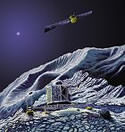
Image credit: ESA
The European Space Agency’s Rosetta mission will be the first spacecraft to ever orbit and then land on a distant comet. Scheduled for launch on board an Ariane-5 rocket as early as January 22, the spacecraft will rendezvous with Comet Wirtanen in 2011. There is some uncertainty about the launch, however, because of a booster accident with an enhanced Ariane-5 last month. The spacecraft must launch by the end of January if it’s to meet up with Wirtanen; otherwise, a new objective will have to be selected.
ESA’s Rosetta will be the first mission to orbit and land on a comet. Comets are icy bodies that travel throughout the Solar System and develop a characteristic tail when they approach the Sun. Rosetta is scheduled to be launched on-board an Ariane-5 rocket in January 2003 from Kourou, French Guiana.
The decision on the launch date will be taken by Tuesday 14 January 2003 (See Arianspace’s press release number 03/02 of 7 January 2003 or look at the web site http://www.arianespace.com). The mission target is Comet Wirtanen and the encounter will occur in 2011. Rosetta’s name comes from the famous Rosetta Stone that, almost 200 years ago, led to the deciphering of Egyptian hieroglyphics. In a similar way, scientists hope that the Rosetta spacecraft will unlock the mysteries of the Solar System.
Comets are very interesting objects for scientists since their composition reflects how the Solar System was when it was very young and still ‘unfinished’, more than 4600 million years ago. Comets have not changed much since then. By orbiting Comet Wirtanen and landing on it, Rosetta will collect essential information to understand the origin and evolution of our Solar System. It will also help discover whether comets contributed to the beginnings of life on Earth. Comets are carriers of complex organic molecules that, when delivered to Earth through impacts, perhaps played a role in the origin of living forms. Furthermore, ‘volatile’ light elements carried by comets may have also played an important role in forming the Earth’s oceans and atmosphere.
“Rosetta is one of the most challenging missions ever undertaken so far,” says Prof. David Southwood, ESA Director of Science. “No one before has attempted a simular mission, unique for its scientific implications as well as for its complex and spectacular interplanetary space manoeuvres.” Before reaching its target in 2011, Rosetta will circle the Sun almost four times on wide loops in the inner Solar System. During its long trek, the spacecraft will have to endure some extreme thermal conditions. Once it is close to Comet Wirtanen, scientists will take it through a delicate braking manoeuvre; then the spacecraft will closely orbit the comet, and gently drop a lander on it. It will be like landing on a small, fast-moving cosmic bullet that has, at present, an almost unknown ‘geography’.
An amazing 8-year interplanetary trek
Rosetta is a 3-tonne box-type spacecraft about 3 metres high, with two 14-metre long solar panels. It consists of an orbiter and a lander. The lander is approximately 1 metre across and 80 centimetres high. It will be attached to the side of the Rosetta orbiter during the journey to Comet Wirtanen. Rosetta carries 21 experiments in total, 10 of them on the lander. They will be kept in hibernation during most of its 8-year trek towards Wirtanen.
What makes Rosetta’s cruise so long? At the time of the rendezvous, Comet Wirtanen will be as far from the Sun as Jupiter is. No launcher could possibly get Rosetta there directly. ESA’s spacecraft will gather speed from gravitational ‘kicks’ provided by three planetary fly-bys: one of Mars in 2005 and two of Earth in 2005 and 2007. During the trip, Rosetta will also visit two asteroids, Otawara (in 2006) and Siwa (in 2008). During these encounters, scientists will switch on Rosetta’s instruments for calibration and scientific studies.
Long trips in deep space include many hazards, such as extreme changes in temperature. Rosetta will leave the benign environment of near-Earth space for the dark, frigid regions beyond the asteroid belt. To manage these thermal loads, experts have done very tough pre-launch tests to study Rosetta’s endurance. For example, they have heated its external surfaces to more than 150 degrees Celsius, then quickly cooled it to -180 degrees Celsius in the next test.
Scientists will fully reactivate the spacecraft prior to the comet rendezvous manoeuvre in 2011. Then, Rosetta will orbit the comet, an object only 1.2 kilometres wide, while it cruises through the inner Solar System at 135 000 kilometres per hour. At the time of the rendezvous, around 675 million kilometres from the Sun, Wirtanen will hardly show any surface activity. The characteristic coma (the comet’s ‘atmosphere’) and the tail will not yet have formed because of the large distance from the Sun. The comet’s tail is made up of dust grains and frozen gases from the comet’s surface that vapourise because of the Sun’s heat.
For six months, Rosetta will extensively map the comet surface, prior to selecting a landing site. In July 2012, the lander will self-eject from the spacecraft from a height of just one kilometre. Touchdown will take place at walking speed – less than 1 metre per second. Immediately after touchdown, the lander will fire a harpoon into the ground to avoid bouncing off the surface back into space. It has to do this because the comet’s extremely weak gravity alone will not hold onto the lander. Operation and scientific observations on the comet surface will last 65 hours as a minimum, but may continue for many months.
During and after the lander operations, Rosetta will continue orbiting and studying the comet. Rosetta will be the first spacecraft to witness at close quarters the changes taking place in a comet when the comet approaches the Sun and grows its coma and tail. The trip will end in July 2013, after 10.5 years of adventure, when the comet is closest to the Sun.
Studying a comet on the spot
Rosetta’s goal is to examine a comet in great detail. The instruments on Rosetta’s orbiter include several cameras, spectrometers, and experiments that work at different wavelengths – infrared, ultraviolet, microwave, radio – and a number of sensors. They will provide, among other things, very high-resolution images and information about the shape, density, temperature, and chemical composition of the comet. Rosetta’s instruments will analyse the gases and dust grains in the so-called coma that forms when the comet becomes active, as well as the interaction with the solar wind.
The 10 instruments on board the lander will do an on-the-spot analysis of the composition and structure of the comet’s surface and subsurface material. A drilling system will take samples down to 30 centimetres below the surface and will feed these to the ‘composition analysers’. Other instruments will measure properties such as the near-surface strength, density, texture, porosity, ice phases, and thermal properties. Microscopic studies of individual grains will tell us about the texture. In addition, instruments on the lander will study how the comet changes during the day-night cycle, and while it approaches the Sun.
Ground operations
Data from the lander are relayed to the orbiter, which stores them for downlink to Earth at the next ground station contact. ESA has installed a new deep-space antenna at New Norcia, near Perth in Western Australia, as the main communications link between the spacecraft and the ESOC Mission Control in Darmstadt, Germany. This 35-metre diameter parabolic antenna allows the radio signal to reach distances of more than 1 million kilometres from Earth. The radio signals, travelling at the speed of light, will take up to 50 minutes to cover the distance between the spacecraft and Earth.
Rosetta’s Science Operations Centre, which is responsible for collecting and distributing the scientific data, will share a location at ESOC and ESTEC in Noordwijk, The Netherlands. The Lander Control Centre is located in DLR in Cologne, Germany, and the Lander Science Centre in CNES in Toulouse, France.
Building Rosetta
Rosetta was selected as a mission in 1993. The spacecraft has been built by Astrium Germany as prime contractor. Major subcontractors are Astrium UK (spacecraft platform), Astrium France (spacecraft avionics), and Alenia Spazio (assembly, integration, and verification). Rosetta’s industrial team involves more than 50 contractors from 14 European countries and the United States.
Scientific consortia from institutes across Europe and the United States have provided the instruments on the orbiter. A European consortium under the leadership of the German Aerospace Research Institute (DLR) has provided the lander. Rosetta has cost ESA Euro 701 million at 2000 economic conditions. This amount includes the launch and the entire period of development and mission operations from 1996 to 2013. The lander and the experiments, the so-called ‘payload’, are not included since they are funded by the member states through the scientific institutes.
Binary Star Ejected From its System
Astronomers from the University of Mexico have found a distant star system where a small, young star has been flung out of its binary star system by the gravitational interaction with its neighbours. The star, called T Tauri Component Sb, has 20% the mass of the Sun, and was part of a group of stars 450 light years from the Earth. The team has been tracking the path of the rogue star since 1983, and watched it slingshot past one star and head out into space.
Columbia Countdown Gets Started
Under a cloak of high security, NASA began the launch countdown for the Space Shuttle Columbia on Monday. If all goes well, the shuttle will launch on Thursday at a secret time – the actual launch time will only be announced 24 hours beforehand. The 16-day microgravity science mission was supposed to launch last year, but cracks discovered in shuttle fuel lines kept the whole fleet grounded while a solution was found. Isreal’s first astronaut, Ilan Ramon, is also due to take part in this mission.
ICESat Launches
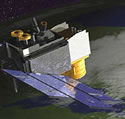
Image credit: NASA
A satellite designed to track the changes in the Earth’s major ice sheets was launched on Sunday after experiencing a month of delays due to technical difficulties. ICESsat (Ice Cloud and Land Elevation
Satellite) was launched aboard a Boeing Delta rocket from the Vandenberg US Air Force Base in California. On board the rocket was another, smaller satellite called CHIPSat, which will help astronomers study the hot gas coming off of stars.
NASA?s Ice, Cloud and Land Elevation satellite (ICESat) and Cosmic Hot Interstellar Spectrometer (CHIPS) satellite lifted off from Vandenberg Air Force Base, Calif., at 4:45 p.m. PST aboard Boeing?s Delta II rocket. Separation of the ICESat spacecraft occurred 64 minutes after launch at 5:49 p.m. PST. Initial contact with ICESat was made 75 minutes after launch at 6 p.m. PST as the spacecraft passed over the Svalbard Ground Station in Norway.
The CHIPS spacecraft separated from the launch vehicle 83 minutes after launch at 6:08 p.m. PST. Initial contact with CHIPS was made 98 minutes after launch at 6:23 p.m. PST as the spacecraft passed over the University of California, Berkeley.
?The Delta vehicle gave us a great ride! The ICESat spacecraft was right where we expected and is performing great. The whole team is thrilled to be having such a wonderful start to our mission? said Jim Watzin, the ICESat Project Manager at NASA?s Goddard Space Flight Center in Greenbelt, Md.
Over the next few days the ICESat spacecraft will gradually be despun and placed into a safe stable attitude. Within two weeks the onboard propulsion system will gradually tune the orbit. Once in its final orbital position, ICESat will be approximately 373 miles (600 kilometers) above the Earth.
ICESat is the latest in a series of Earth Observing System spacecraft, following the Terra satellite launched in December 1999, and the Aqua satellite launched earlier in May of this year. The primary role of ICESat is to quantify ice sheet growth or retreat and to thereby answer questions concerning many related aspects of the Earth?s climate system, including global climate change and changes in sea level.
Ball Aerospace and Technologies Corporation (Ball) in Boulder, Colorado built the ICESat spacecraft. The Earth Science Data and Information System at NASA Goddard will provide space and ground network support and the University of Colorado?s Laboratory for Atmospheric and Space Physics will team with Ball to provide mission operations and flight dynamics support. The GLAS and ICESat data will be initially processed at the ICESat Investigator-led Processing System with support from the University of Texas, Center for Space Research. The mission data will be distributed and archived by the National Snow and Ice Data Center.
Original Source: NASA News Release
Hubble Spots Earliest Bright Objects
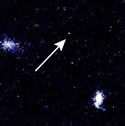
Image credit: Hubble
The most recent photos released from the Hubble Space Telescope show objects so old they might be from a time when stars in the universe were just starting to shine in significant numbers – about 13 billion years ago. These objects are at the limit of Hubble’s resolving power, but the next generation James Webb Space Telescope is expected to see the entire group of proto-galaxies, and look back even further.
Researchers using NASA’s Hubble Space Telescope reported today they are seeing the conclusion of the cosmic epoch called the “Dark Ages,” a time about a billion years after the big bang when newly-formed stars and galaxies were just starting to become visible.
“With the Hubble Telescope, we can now see back to the epoch when stars in young galaxies began to shine in significant numbers, concluding the cosmic ‘dark ages’ about 13 billion years ago,” said Haojing Yan, a Ph.D. graduate student at Arizona State University (ASU). The results are being presented at the meeting of the American Astronomical Society in Seattle, WA.
Current theory holds that after the big bang that created the universe, there was a time of expansion and cooling that led to what is known as the “dark ages” in cosmic terms. The universe cooled sufficiently for protons and electrons to combine to form neutral hydrogen atoms and block the transmission of light. This epoch started about 300,000 years after the big bang, and may have ended about a billion years later. Stars and galaxies started to form at some point during this era, but the omni-present neutral hydrogen in the universe absorbed the ultraviolet light produced by stars and can not be seen by current telescopes.
The ASU team reports that Hubble’s Advanced Camera for Surveys (ACS) is revealing numerous faint objects that may be young star-forming galaxies seen when the universe was seven times smaller than it is today and less than a billion years old.
This was an important transition in the evolution of the universe. Because ionized hydrogen does not absorb ultraviolet light as easily as neutral hydrogen, the Dark Ages came to an end when enough hot stars had formed that their ultraviolet light pervaded the universe and re-ionized the neutral hydrogen. The shining stars opened a window for astronomers to look very far back into time.
“The objects we found are in the epoch when the universe started to produce stars in significant numbers ?- the hard-to-find young galaxies,” says Rogier Windhorst, professor of astronomy at ASU. “These galaxies are at the boundary of the directly observable universe.”
The ASU team found the objects while examining a small portion of the sky in the spring zodiacal constellation Virgo. This particular area of the sky contains no known bright galaxies, helping reduce light contamination in the observations. The entire ACS field of view shows about thirty such faint red objects. The distances to the suspected young galaxies are believed to be quite large, based on how red the observed objects are compared with nearby galaxies.
Based on this sample, the ASU researchers estimate that at least 400 million such objects filled in the entire universe at this cosmic epoch, to the limit of this Hubble image. And, they say they are able to see only the tip of the iceberg with current telescopes such as Hubble. NASA’s planned 7-meter James Webb Space Telescope is expected to see the entire population of these proto-galactic objects after it is launched in 2010.
Original Source: Hubble News Release
Gravity Moves at the Speed of Light
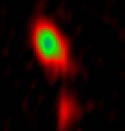
Image credit: NRAO
Theorized by Einstein for almost a century, physicists have found evidence to support the theory that the force of gravity moves at the speed of light. The speed was measured by physicist Sergei Kopeikin by watching how light from a distant quasar was bent by Jupiter’s gravity. Variations in how the image of the quasar was bent accounted for this speed of gravity.
Taking advantage of a rare cosmic alignment, scientists have made the first measurement of the speed at which the force of gravity propagates, giving a numerical value to one of the last unmeasured fundamental constants of physics.
“Newton thought that gravity’s force was instantaneous. Einstein assumed that it moved at the speed of light, but until now, no one had measured it,” said Sergei Kopeikin, a physicist at the University of Missouri-Columbia.
“We have determined that gravity’s propagation speed is equal to the speed of light within an accuracy of 20 percent,” said Ed Fomalont, an astronomer at the National Radio Astronomy Observatory (NRAO) in Charlottesville, VA. The scientists presented their findings to the American Astronomical Society’s meeting in Seattle, WA.
The landmark measurement is important to physicists working on unified field theories that attempt to combine particle physics with Einstein’s general theory of relativity and electromagnetic theory.
“Our measurement puts some strong limits on the theories that propose extra dimensions, such as superstring theory and brane theories,” Kopeikin said. “Knowing the speed of gravity can provide an important test of the existence and compactness of these extra dimensions,” he added.
Superstring theory proposes that the fundamental particles of nature are not pointlike, but rather incredibly small loops or strings, whose properties are determined by different modes of vibration. Branes (a word derived from membranes) are multidimensional surfaces, and some current physical theories propose space-time branes embedded to five dimensions.
The scientists used the National Science Foundation’s Very Long Baseline Array (VLBA), a continent-wide radio-telescope system, along with the 100-meter radio telescope in Effelsberg, Germany, to make an extremely precise observation when the planet Jupiter passed nearly in front of a bright quasar on September 8, 2002.
The observation recorded a very slight “bending” of the radio waves coming from the background quasar by the gravitational effect of Jupiter. The bending resulted in a small change in the quasar’s apparent position in the sky.
“Because Jupiter is moving around the Sun, the precise amount of the bending depends slightly on the speed at which gravity propagates from Jupiter,” Kopeikin said.
Jupiter, the largest planet in the Solar System, only passes closely enough to the path of radio waves from a suitably bright quasar about once a decade for such a measurement to be made, the scientists said.
The once-in-a-decade celestial alignment was the last in a chain of events that made measuring the speed of gravity possible. The others included a chance meeting of the two scientists in 1996, a breakthrough in theoretical physics and the development of specialized techniques that enabled the extremely precise measurement to be made.
“No one had tried to measure the speed of gravity before because most physicists had assumed that the only way to do so was to detect gravitational waves,” Kopeikin recalled. However, in 1999, Kopeikin extended Einstein’s theory to include the gravitational effects of a moving body on light and radio waves. The effects depended on the speed of gravity. He realized that if Jupiter moved nearly in front of a star or radio source, he could test his theory.
Kopeikin studied the predicted orbit of Jupiter for the next 30 years and discovered that the giant planet would pass closely enough in front of the quasar J0842+1835 in 2002. However, he quickly realized that the effect on the quasar’s apparent position in the sky attributable to the speed of gravity would be so small that the only observational technique capable of measuring it was Very Long Baseline Interferometry (VLBI), the technique embodied in the VLBA. Kopeikin then contacted Fomalont, a leading expert in VLBI and an experienced VLBA observer.
“I immediately realized the importance of an experiment that could make the first measurement of a fundamental constant of nature,” Fomalont said. “I decided that we had to give this our best shot,” he added.
To get the required level of precision, the two scientists added the Effelsberg telescope to their observation. The wider the separation between two radio-telescope antennas, the greater is the resolving power, or ability to see fine detail, achievable. The VLBA includes antennas on Hawaii, the continental United States, and St. Croix in the Caribbean. An antenna on the other side of the Atlantic added even more resolving power.
“We had to make a measurement with about three times more accuracy than anyone had ever done, but we knew, in principle, that it could be done,” Fomalont said. The scientists tested and refined their techniques in “dry runs,” then waited for Jupiter to make its pass in front of the quasar.
The wait included considerable nail-biting. Equipment failure, bad weather, or an electromagnetic storm on Jupiter itself could have sabotaged the observation. However, luck held out and the scientists’ observations at a radio frequency of 8 GigaHertz produced enough good data to make their measurement. They achieved a precision equal to the width of a human hair seen from 250 miles away.
“Our main goal was to rule out an infinite speed for gravity, and we did even better. We now know that the speed of gravity is probably equal to the speed of light, and we can confidently exclude any speed for gravity that is over twice that of light,” Fomalont said.
Most scientists, Kopeikin said, will be relieved that the speed of gravity is consistent with the speed of light. “I believe this experiment sheds new light on fundamentals of general relativity and represents the first of many more studies and observations of gravitation which are currently possible because of the enormously high precision of VLBI. We have a lot more to learn about this intriguing cosmic force and its relationship to the other forces in nature,” Kopeikin said.
This is not the first time that Jupiter has played a part in producing a measurement of a fundamental physical constant. In 1675, Olaf Roemer, a Danish astronomer working at the Paris Observatory, made the first reasonably accurate determination of the speed of light by observing eclipses of one of Jupiter’s moons.
Original Source: NRAO News Release
Neptune Has a Trojan
Astronomers have discovered a new object which shares a very similar orbit with Neptune. Part of a classification of objects called Trojans, 2001 QR322 is 230 km across and requires 166 years to orbit the Sun. Although clusters of Trojans have been found following Jupiter’s orbit, none have ever been found to share an orbit with any other giant planet; although, they’ve been predicted for years.
Protoplanetary Disk Found Around a Star
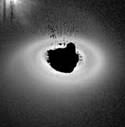
Image credit: Hubble
The new Advanced Camera for Surveys (ACS) on the Hubble Space Telescope has revealed a clear disk of dust around a young, 5 million year old star. Astronomers believe these disks are the birthplaces of planets. The star, called HD 141569A is part of a triple star system located 320 light-years away in the constellation of Libra.
NASA Hubble Space Telescope’s new Advanced Camera for Surveys (ACS) has given astronomers their clearest view yet of the dust disk around a young, 5-million-year-old star. Such disks are expected to be the birthplace of planets. The star, called HD 141569A, lies 320 light-years away in the constellation Libra and appears to be a member of a triple-star system.
The star HD 141569A was first identified as a candidate for a circumstellar disk in 1986, from observations done with the NASA/Netherlands/United Kingdom Infrared Astronomy Satellite (IRAS). An excess of infrared radiation associated with the star provides telltale evidence for the presence of a dust disk. Hubble’s Near Infrared Camera and Multi-Object Spectrometer photographed the disk in 1999 and revealed two concentric rings divided by a dark lane. This was interpreted as evidence of dynamical sculpting by one or more planets.
The ACS reveals that the disk’s structure is much more complex than previously thought. The disk is actually a tightly wound spiral structure. The outer regions of the disk reveal two diffuse spiral arms, one of which appears to be associated with the nearby double star system (HD 141569BC) seen at the upper left. The apparent connection between the disk and the double star suggest that an interaction with the double star may be responsible for the structures seen in the disk.
However, previous mid-IR images of the disk show that it is relatively clear of dust within approximately 2.8 billion miles of the star. This inner region may have been swept clear by one or more unseen planets.
These observations of the disk were obtained with the ACS’s High Resolution Camera (HRC) coronagraph. The photo on the left is a processed visible light image. In the photo on the right, the disk has been geometrically altered to simulate a face-on view, and false-color has been applied to enhance the disk structure. The black center marks regions where light from the star has been masked out. These images are the first results of a survey of disks around young main-sequence stars being conducted by the ACS science team.
Original Source: Hubble News Release
